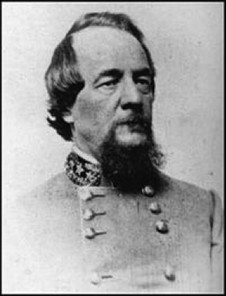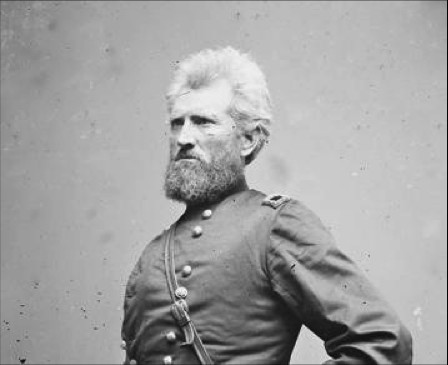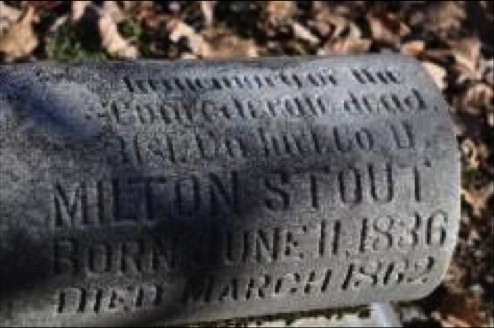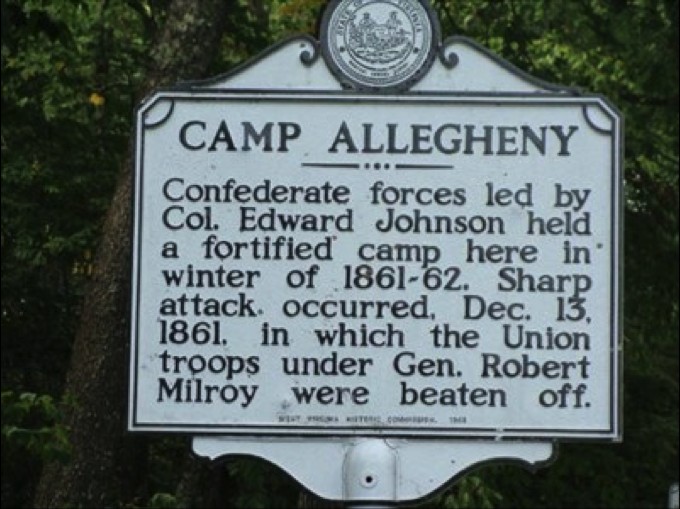Battle of Camp Allegheny, December 13, 1861
Introduction
Text-to-speech Audio
Images
Colonel Edward Johnson

Brigadier General Robert H. Milroy

A gravestone at the cemetery of Camp Allegheny

Camp Allegheny historical marker.

Backstory and Context
Text-to-speech Audio
In November 1861 Confederate forces under Colonel Edward Johnson of the 12th Georgia Infantry was given orders to garrison the mountain pass overlooking Staunton-Parkersburg Turnpike. Colonel Edward “Allegheny” Johnson remained in the camp through April 1862 where he and his men endured a harsh and brutal winter. Throughout the winter of 1861-April 1862 more Confederate soldiers died from exposure and disease than in the small battle that would occur here on December 13, 1861.
The Staunton-Parkersburg Turnpike was an important route, especially for the Confederate army as it allowed them to move men and materiel from Staunton in the Shenandoah Valley to Parkersburg and the Ohio River. This turnpike running through the Appalachian Mountains was important to both the Confederation and Union and control of supply routes like this played a major role in many Civil War battles.
On the morning of December 13, 1861, Union soldiers led by General Milroy moved to attack Confederate soldiers at Camp Allegheny with a two-pronged attack. The two Union detachments were not in contact with one another and one came much after the initial attack which made it possible for the Confederate defenders to maneuver men to meet each flank. The attack was poorly coordinated as the mountainous region was difficult to maneuver and proved impossible for a coordinated attack.
Both sides fought with vigor, but ultimately General Milroy retreated to Cheat Mountain owing to Confederate artillery and holding superior ground. Colonel Johnson was given the nickname “Allegheny Johnson” for his victory as his 1200 men had turned back approximately 1,900 Union soldiers. The Union lost about twenty men and an additional one hundred and seven were wounded with ten missing. On the Confederate side, there was an estimated twenty killed, ninety-eight wounded, and twenty-eight missing.
Camp Allegheny is also part of the Civil War Discovery Trail program which connects Civil War sites in over thirty states. Camp Allegheny is listed on the National Register of Historic Places and includes multiple earthworks that were constructed by soldiers as well as a campground and a church site with a cemetery where many of the soldiers who died were laid to rest.
Cite This Entry
Wade, Brandon and Clio Admin. "Battle of Camp Allegheny, December 13, 1861 ." Clio: Your Guide to History. July 15, 2018. Accessed April 6, 2025. https://theclio.com/tour/2094/20
Sources
McBride, Kim A. National Register of Historic Places Application. November 29, 1989. Accessed September 17, 2017. http://www.wvculture.org/shpo/nr/pdf/pocahontas/90001446.pdf.
Dispersed Camping. Allegheny National Forest. Accessed September 17, 2017. https://www.fs.usda.gov/activity/allegheny/recreation/camping-cabins/?recid=6083&actid=34.
Steelhammer, Rick. Civil War battle in Pocahontas 150 years ago. Charleston Gazette Mail. December 12, 2011. Accessed September 17, 2017. http://www.wvgazettemail.com/News/201112120103.
Review of Camp Allegheny. “One of the Great Civil War Sites”. Accessed September 17, 2017. https://www.tripadvisor.com/ShowUserReviews-g59035-d292766-r204376252-Camp_Allegheny-Elkins_West_Vir....
camp allegheny battlefield. Google Pictures. Accessed September 17, 2017. https://www.google.com/search?biw=1233&bih=590&tbm=isch&sa=1&q=camp+allegheny+battlefield&oq=camp+al.... Web Pictures
Geiger Jr., Joe. Civil War Books and Authors. Geiger: "HOLDING THE LINE: The Battle of Allegheny Mountain and Confederate Defense of the Staunton-Parkersburg Turnpike, 1861-62". October 17, 2012. Accessed 10/03/2017. https://cwba.blogspot.com/2012/10/geiger-holding-line-battle-of-allegheny.html.

